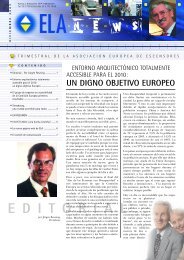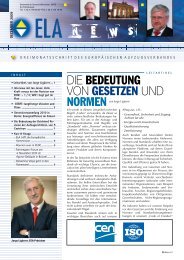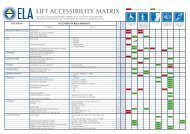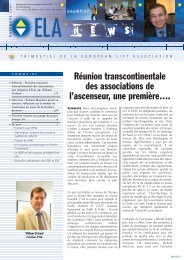WP6-Brochure-E4 brochure - ELA European Lift Association.
WP6-Brochure-E4 brochure - ELA European Lift Association.
WP6-Brochure-E4 brochure - ELA European Lift Association.
Create successful ePaper yourself
Turn your PDF publications into a flip-book with our unique Google optimized e-Paper software.
Identification of stakeholders and actors<br />
Besides manufacturing and maintenance companies, as well as users of lifts and escalators,<br />
several additional stakeholders and actors may be involved in the process of choosing a new<br />
installation or in the decision‐making processes related to retrofitting an existing one (see<br />
Figure 7‐1 for an overview of stakeholders). To a lesser or higher degree, all of these<br />
stakeholders influence the energy efficiency of the equipment and therefore need to be taken<br />
into account.<br />
Manufacturing companies often act as full service companies, offering everything from<br />
support in planning and choosing a new installation up to repair and maintenance and finally<br />
retrofitting. Thus their influence on the energy efficiency of an installation is probably<br />
extensive, as they are involved in all stages. Increasingly, manufacturers rely on the support of<br />
contracted companies for the installation of new equipment – thus adding an additional actor.<br />
On the buyer side, in the case of a new building, first of all, the decision has to be taken,<br />
whether to include a lift or escalator or not. Increasingly, national or regional legislation and<br />
regulation recommend including equipment to ensure accessibility to buildings for all groups<br />
of individuals. 3 In the next step, the number, size and location of installations has to be<br />
determined. Within this step, besides the construction company and the architect,<br />
construction engineers as well as lift consultants may be involved in dimensioning and<br />
situating lifts and escalators.<br />
After completing the building, operators and administrators for the building and the technical<br />
installations come into play as well as service and maintenance personnel, either from the lift<br />
and escalator industry or as separate companies. Depending on the type of building and its<br />
use, the final owner 4 may also be the user of an installation, e.g., in the residential sector, if a<br />
building is commonly owned by its occupants. However, in other cases, the owner may hardly<br />
or never use the installation, e.g. in case of a shopping mall which is owned by an investment<br />
company. In any case, all of these stakeholders are crucial when it comes to monitor the<br />
energy consumption of an existing installation as well as to initiating a retrofit. However, their<br />
networking and interaction as well as their influence may vary significantly.<br />
Banks are often part of the process as well, as financers of the whole process. Although it is<br />
very unlikely that they will directly influence the choice of model for a lift or escalator, they<br />
may exert influence by limiting the amount of capital that is available for investment.<br />
A probably more significant role is played by notified bodies as well as market surveillance.<br />
Notified bodies like the German and Austrian TÜV, the Dutch <strong>Lift</strong>instituut or the British SAFed<br />
are involved, as they are certified to check the safety of installed equipment and may thereby<br />
3 For example. the German norm DIN 18024‐2.<br />
4 The term 'final owner' refers to the fact that buildings may be owned by a construction company, general<br />
contractor or investment company during their development and construction phase, but however be sold to<br />
another organization or individual after completion.<br />
89

















